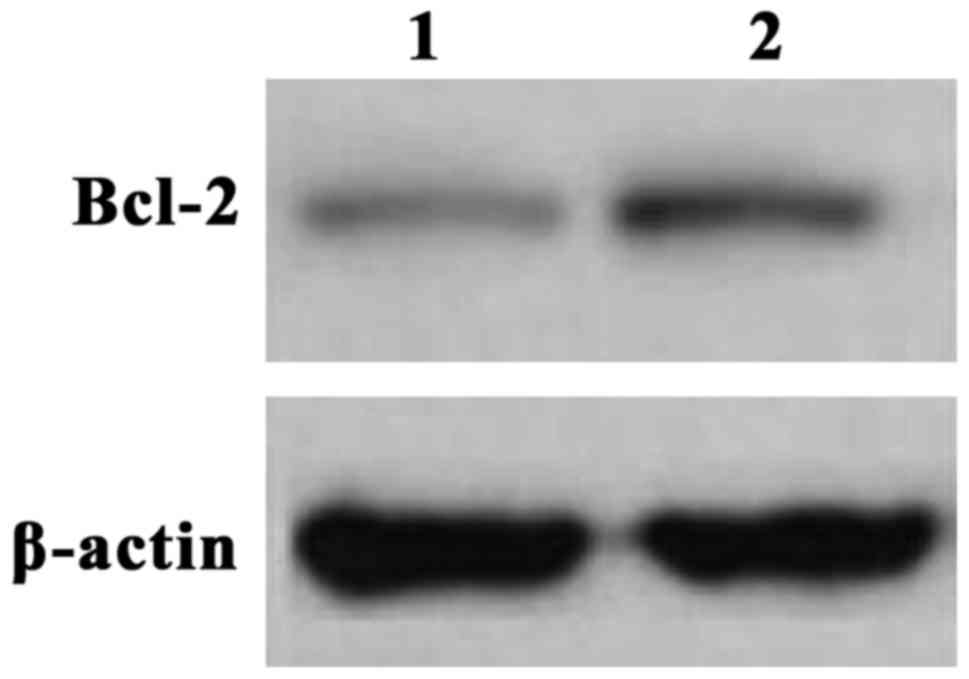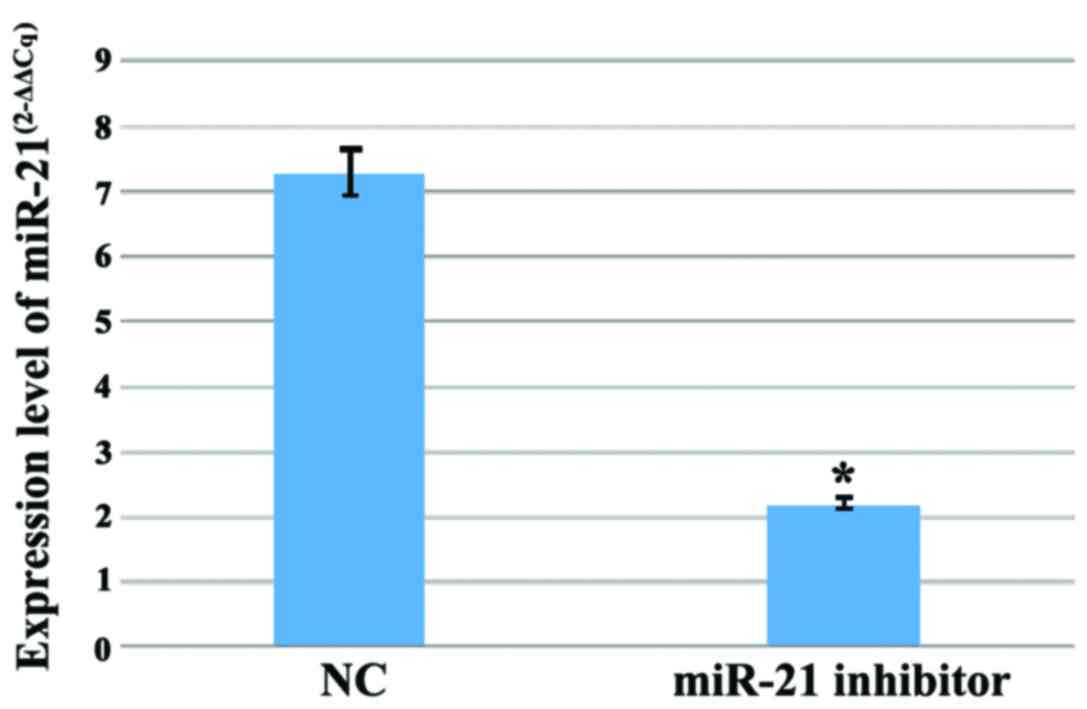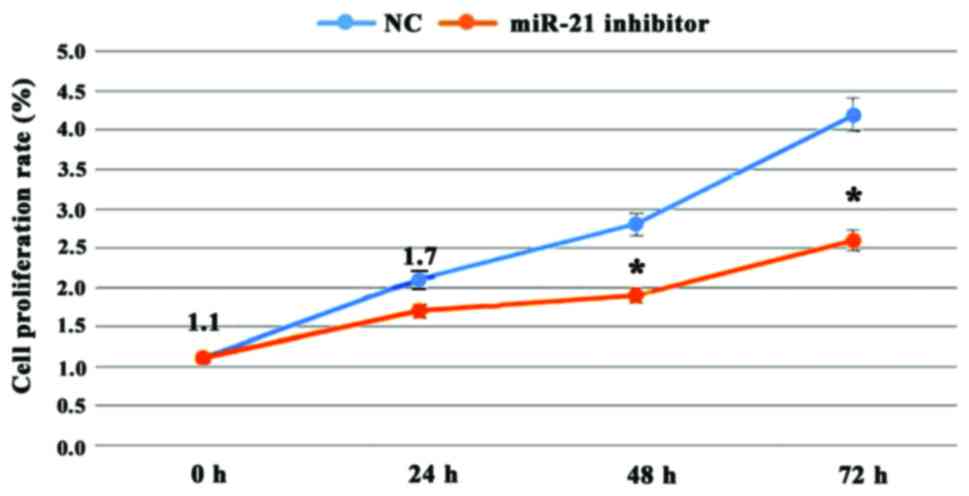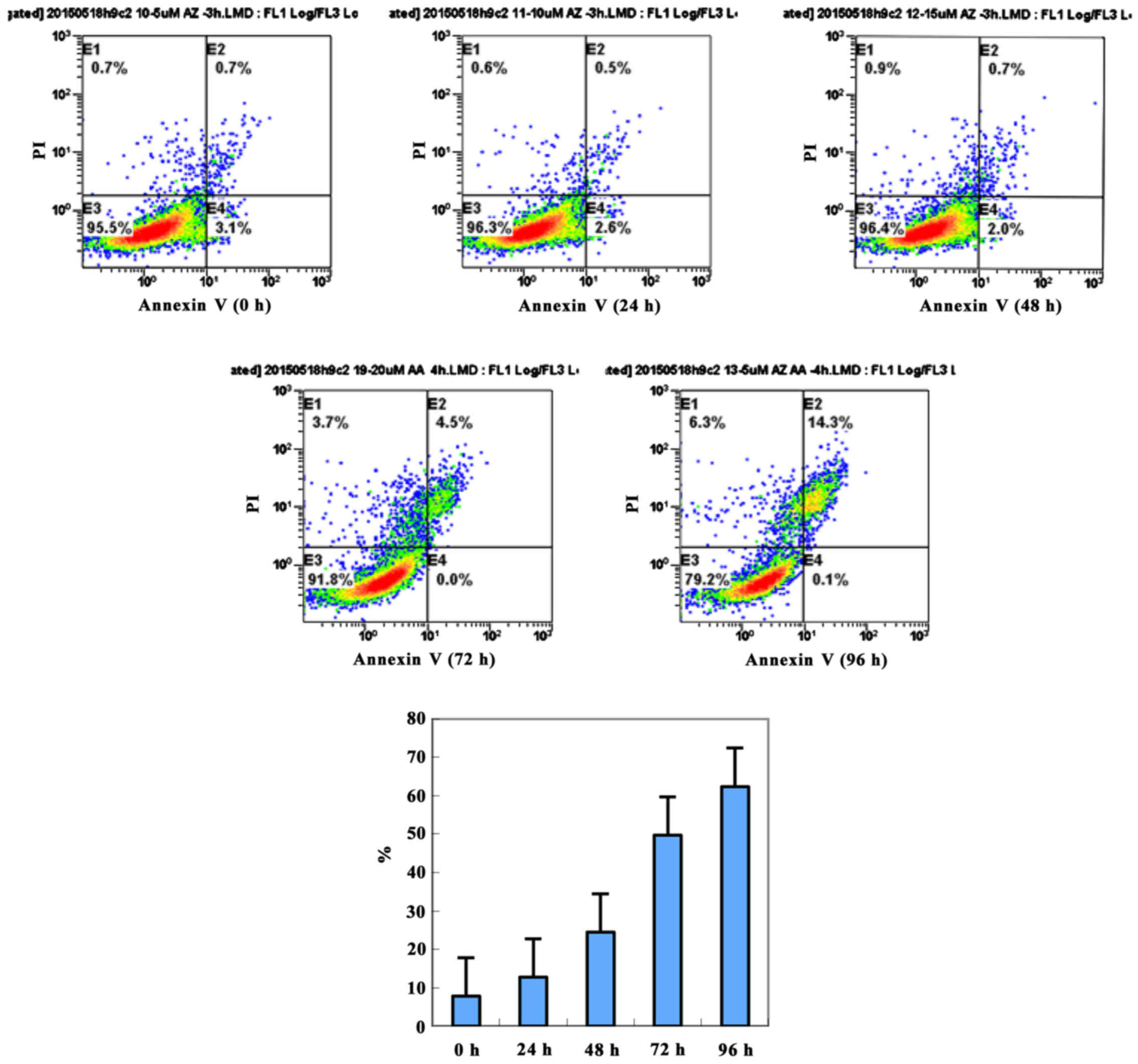Effects of miR-21 on proliferation and apoptosis in human gastric adenocarcinoma cells
- Authors:
- Published online on: May 15, 2017 https://doi.org/10.3892/ol.2017.6171
- Pages: 618-622
-
Copyright: © Gu et al. This is an open access article distributed under the terms of Creative Commons Attribution License.
Abstract
Introduction
The incidence of gastric cancer in the digestive tract is 13.9% with a continuous increasing trend (1). The complex pathogenesis of cancer involves oncogene activation, mutation of tumor suppressor genes, and proliferation of malignant cells. In addition, apoptosis is inhibited in the malignant cells (2). The deregulation of proliferation and/or apoptosis induces the appearance of malignant tumors (3). MicroRNAs (miRs) are non-coding RNAs that control gene expression. A recent study confirmed that the development of malignant tumors is highly related to the activation and expression of specific miRs (4). Abnormal expression of miRs can contribute to the dysregulation of oncogenes or tumor suppressor genes, exerting a tremendous influence on the development of malignant tumors and the progression of cancers (5). Investigating miRs can contribute to understanding the mechanism of proliferation, apoptosis, invasion, and metastasis of gastric cancer cells, and have the potential to become alternative therapeutic targets. Previous findings verified the abnormal expression of miRs in gastric cancer tissues (5,6). Thus, specific miRs can be used as markers to distinguish normal and malignant tissues, with the potential to become promising targets for testing, diagnosing, and treating gastric cancer (7,8).
Bcl-2 is an anti-apoptotic gene located on human chromosome 18q21 (9) highly expressed in stem cells of human tissues, including skin basal collagen cells and small intestinal crypt bottom cells. By inhibiting cell apoptosis, Bcl-2 ensures that the cells have sufficient time to complete their transformation from stem cells into highly differentiated cells (10). Previous results have verified that Bcl-2 is closely related to the occurrence and development of lymphoma, colorectal, breast, cervical, and thyroid cancer (11–13). Other studies demonstrate that Bcl-2 is also linked to the prognosis of certain tumors (14). In addition, a high expression of Bcl-2 is closely associated with the invasion and metastasis of malignant tumor cells and recent studies showed that the expression of Bcl-2 in tumor cells can be inhibited by artificial methods, leading to the increase of cancer cell sensitivity to chemotherapeutic drugs (15). In addition, we downregulation of Bcl-2 induces and speeds apoptosis in primary tumor cells.
We further investigated the role of miR-21 in the occurrence and development of gastric cancers by analyzing gastric cancer pathology and adjacent normal tissues. We examined the potential mechanisms of miR-21 to provide a novel biomarker for early diagnosis and provide a rationale for new treatments of gastric cancer.
Materials and methods
Tissue processing
Gastric carcinoma and the corresponding normal gastric tissue were stored at −80°C. The samples were ground and the powder was placed in a pre-processed tube, adding 500 µl TRIzol, and mixed for 15 sec; 170 µl chloroform was added with 15 sec mixing and centrifugation at 10,000 × g for 10 min. Supernatant (400 µl) was added to a new tube, 500 µl isopropanol was added with 15 sec mixing with the vortex, then centrifuge at 10,000 × g for 10 min at 4°C. Supernatant was discard, the white sediment at the bottom of the tube was air dried. Total RNA was dissolved in 50 µl DEPC water.
Western blot analysis
Two hundred milligrams of tissue was sheared and 1 ml of lysate was added; homogenated and centrifuged at 6,200 × g for 10 min, the supernatant was transferred to a new tube; centrifuge at 10,000 × g for 60 min, and the supernatant was transferred to a new tube. The protein content was determined with the protein kit BCA™.
Flow cytometry
The MGC803 human gastric cancer cell line was transfected with miR-21, after which the cells were starved for 48 h after transfection. Then, we trypsinized the cells (0.25% trypsin) into a single cell suspension and used Annexin V-FITC/PI to detect apoptosis by cytometer. Primer sequences used were: miR-21 forward, 5′-TCCGAAGTTGTAGTCAGACT-3′ and reverse, 5′-GTGCAGGGTCCGAGGT-3′.
MTT assay
MGC803 cells transfected with miR-21 were trypsinized and re-suspended in Dulbecco's modified Eagle's medium (DMEM) culture medium containing 10% fetal bovine serum (FBS). The cells were seeded in 96-well culture plates with a volume of 200 µl per well. The 96-well culture plates were placed in 5% CO2 cell culture incubator with saturated humidity and 37°C for 3–5 days. MTT solution (20 µl) was then added to each well, and the cells were incubated in the incubator for 4 h. The culture medium was discarded, 150 µl DMSO was added per well, and shaken for 10 min. Absorbance was measured at 92 nm in the cell culture medium using enzyme-linked immunosorbent assay, and the cell growth curve was drawn with the time as the horizontal coordinate. The DMEM (FBS-free) was used to dilute the Matrigel. MGC803 cells were cultured with serum-free DMEM for 24 h. The supernatant was used as the chemotaxis solution with 0.05–0.2% BSA. MGC803 cells were washed with PBS 2–3 times. Cell culture medium (DMEM-free) was added and the cells were placed in the incubator for 24 h. The supernatant was discarded and digested with 0.25% trypsin. The supernatant was discarded, and DMEM with 5% BSA was used to re-suspend cells; 300 µl DMEM (FBS-free) was added to the upper chamber; 200 µl chemotaxis solution was added to the lower chamber, and the Matrigel was covered; 400 µl cell suspension was added to the upper chamber and incubated for 48 h; 95% ethanol was used for 30 min and then stained with H&E. Five fields of view were selected to count and take the average value of the transmembrane cells. The above experiments were repeated three times.
Results
Levels of miR-21 and Bcl-2 mRNA in gastric cancer and adjacent normal tissue
To examine the role of miR-21 and Bcl-2 in gastric cancer, we extracted total RNA from gastric cancer samples and adjacent normal tissue to measure mRNA levels. We measured mRNA levels of miR-21 and Bcl-2 by fluorescent quantitative PCR in 50 pairs of gastric cancer tissues and the adjacent normal tissues (Tables I and II). The ΔCT values for miR-21 in the gastric cancer group were significantly higher than those in the control group (Table I). In addition, the ΔCT values for Bcl-2 mRNA in the gastric cancer group was also significantly higher that in the control group (Table II).
Expression of Bcl-2 in gastric cancer
We next validated the elevated Bcl-2 mRNA expression by analyzing the protein levels. The expression of Bcl-2 in the gastric cancer and control group were measured and tested by western blot analysis. Compared to the control group, the level of the Bcl-2 protein in the gastric cancer group was significantly higher (Fig. 1), supporting the results with mRNA levels.
Correlation of Bcl-2 expression and clinical features
We investigated the correlation between Bcl-2 protein expression in gastric adenocarcinoma and clinical features (Table III). Expression of Bcl-2 protein was not associated to age and locations of the tumor. However, we found a strong association with the tumor clinical stage, tumor cell invasion of lymph nodes, and the tumor metastasis degree (Table III). We also compared the relative expression of miR-21 and Blc-2 mRNA by Spearman test. We found a strong correlation of the expression of miR-21 and Blc-2 mRNA.
Inhibition of miR-21 in MGC803 cells
To investigate the functional relevance of miR-21 expression in gastric adenocarcinoma, we introduced the miR-21 inhibitor into MGC803 cells and normal cells. We measured the expression levels of miR-21 after 48 h. Compared to normal cells, the expression of miR-21 in MGC803 cells was significantly reduced (Fig. 2).
The Protein expression of Bcl-2 in MGC803 lineage and normal cells
We examined Bcl-2 expression, cell proliferation, apoptosis and invasion on MGC803 cells treated with miR-21. We found that miR-21 inhibition resulted in significantly lower levels of Bcl-2 protein (Table IV).
Proliferation of MGC803 after miR-21 inhibition
The proliferation of the MGC803 cells using the MMT assay was determined. We incubated normal and MGC803 cells for 24, 48 and 72 h with miR-21 inhibitor found at each time-point the proliferation of the MGC803 cells was decreased compared to the control group (Fig. 3). At each time-point the differences were statistically significance (P<0.01).
Apoptosis in MGC803 cells after miR-21 inhibition
To further investigate the effects of miR-21 in MGC803 apoptosis, we used Annexin V-FITC/PI double stain. We evaluated MGC803 apoptosis at different time-points (0, 24, 48, 72 and 96 h) after miR-21 inhibition. As time progressed, MGC803 apoptosis showed acceleration (Fig. 4). At each time-point, the apoptosis of the MGC803 cells was higher than that in normal cells (Fig. 4).
Invasion of MGC803 cells after miR-21 inhibition
The cell invasion ability is one of the key features of tumors, which can represent the malignancy degree of the tumor. To investigate gastric cancer cell invasion, the Transwell assay was used to evaluate the ability of MGC803 to invade after miR-21 inhibition. Compared with the control group, the invasion ability of the MGC803 was significantly decreased (P<0.01) (Fig. 5).
Discussion
The rapid development of molecular biology and modern cancer medicine has revealed the correlation between miR expression and the development of malignant tumors. miRs can regulate the expression of one third of genes in the human genome and have been shown to exert many physiological functions in cell development, proliferation, differentiation, apoptosis, and metastasis. The expression levels of miRs are altered changed (increased or decreased) in most malignant tumor tissues compared to normal tissues, suggesting strong connection between miRs and the development of tumors (16–20). The malignant tumor growth, proliferation, invasion, and metastasis, and apoptosis are closely correlated to abnormal expression of miRs and its aberrant regulatory activities.
Our experiments show that miR-21 mRNA and Bcl-2 mRNAs were significantly elevated in gastric adenocarcinoma and miR-21 inhibition reduced the proliferation and increase the apoptosis of MGC803 cells. Antisense inhibition of miR-21 can activate malignant cells apoptosis (21). The study of antisense oligonucleotides decreased the expression of miR-21 in glioma cells and cell number, while the activity of caspase-3 and −7 were significantly increased. Our experiments show that miR-21 inhibition had similar effects on gastric adenocarcinoma. The inhibitory effect of Bcl-2 on apoptosis mainly form channel protein in three steps (22–25): i) Increase cell membrane permeability to inhibit the release of mitochondrial apoptotic proteins, and ultimately inhibit apoptosis; ii) improve cellular antioxidant, scavenging oxygen free radicals to suppress apoptosis; and iii) block calcium ion transmembrane flow through intracellular calcium ion concentration regulation to inhibit apoptosis.
Using artificial approaches to inhibit the miR-21 in cholangiocarcinoma cells showed that miR-21 promoted the effectiveness of the chemotherapy drug gemcitabine by inducing apoptosis (26). This suggests that miR-21 activates the PI3K signaling pathway. Lund et al (27) showed that miR-21 can reduce the expression of PDCD4 in breast cancer cells, thus promoting the transformation of tumor cells. In colon cancer samples and cell lines, miR-21 can regulate the target gene of PDCD4, thus, suggesting a key role in growth and invasion.
Our study also found that Bcl-2 was associated with clinical staging, lymph node metastasis, and tumor differentiation. The relative expression of miR-21 and Bcl-2 mRNA were strongly correlated with gastric cancer. Other research found that the content of miR-21 in breast cancer tissue was significantly higher than in normal tissue (28,29). miR-21 was also associated with tumor clinical stage, vascular invasion, and tumor cell proliferation, suggesting a similar role for miR-21 in breast and gastric cancer. A study found that the apoptosis induced factor of PDCD4 inhibits the expression of miR-21 in MCF-7 cells, and miR-21 can play an antagonistic role to p53 apoptosis pathway by inhibition of the tumor suppressor protein p53 (30). Finally, we found that miR-21 promotes the expression of Bcl-2 protein, and miR-21 inhibition decreased cell proliferation. The mechanisms regulating miR-21 high expression in gastric adenocarcinoma tissues are still unclear. One possibility is that miR-21 promotes the proliferation and invasion of human MGC803 cells and the inhibition of apoptosis.
In conclusion, our study reports higher levels of miR-21 in gastric adenocarcinoma, and we discuss the possible role of miR-21 in regulating MGC803 cell apoptosis. Our study supports the potential for miR-21 as a marker for early diagnosis and target treatment for gastric adenocarcinoma.
References
|
Lee JH, Kim JG, Jung HK, Kim JH, Jeong WK, Jeon TJ, Kim JM, Kim YI, Ryu KW, Kong SH, et al: Clinical practice guidelines for gastric cancer in Korea: An evidence-based approach. J Gastric Cancer. 14:87–104. 2014. View Article : Google Scholar : PubMed/NCBI | |
|
Long ZW, Yu HM, Wang YN, Liu D, Chen YZ, Zhao YX and Bai L: Association of IL-17 polymorphisms with gastric cancer risk in Asian populations. World J Gastroenterol. 21:5707–5718. 2015. View Article : Google Scholar : PubMed/NCBI | |
|
Chen XZ, Chen H, Castro FA, Hu JK and Brenner H: Epstein-Barr virus infection and gastric cancer: a systematic review. Medicine (Baltimore). 94:e7922015. View Article : Google Scholar : PubMed/NCBI | |
|
Kanaan Z, Rai SN, Eichenberger MR, Roberts H, Keskey B, Pan J and Galandiuk S: Plasma miR-21: a potential diagnostic marker of colorectal cancer. Ann Surg. 256:544–551. 2012. View Article : Google Scholar : PubMed/NCBI | |
|
Li T, Li RS, Li YH, Zhong S, Chen YY, Zhang CM, Hu MM and Shen ZJ: miR-21 as an independent biochemical recurrence predictor and potential therapeutic target for prostate cancer. J Urol. 187:1466–1472. 2012. View Article : Google Scholar : PubMed/NCBI | |
|
Liu XG, Zhu WY, Huang YY, Ma LN, Zhou SQ, Wang YK, Zeng F, Zhou JH and Zhang YK: High expression of serum miR-21 and tumor miR-200c associated with poor prognosis in patients with lung cancer. Med Oncol. 29:618–626. 2012. View Article : Google Scholar : PubMed/NCBI | |
|
Han M, Wang Y, Liu M, Bi X, Bao J, Zeng N, Zhu Z, Mo Z, Wu C and Chen X: MiR-21 regulates epithelial-mesenchymal transition phenotype and hypoxia-inducible factor-1α expression in third-sphere forming breast cancer stem cell-like cells. Cancer Sci. 103:1058–1064. 2012. View Article : Google Scholar : PubMed/NCBI | |
|
Lakomy R, Sana J, Hankeova S, Fadrus P, Kren L, Lzicarova E, Svoboda M, Dolezelova H, Smrcka M, Vyzula R, et al: MiR-195, miR-196b, miR-181c, miR-21 expression levels and O-6-methylguanine-DNA methyltransferase methylation status are associated with clinical outcome in glioblastoma patients. Cancer Sci. 102:2186–2190. 2011. View Article : Google Scholar : PubMed/NCBI | |
|
Lu QL, Abel P, Foster CS and Lalani EN: bcl-2: role in epithelial differentiation and oncogenesis. Hum Pathol. 27:102–110. 1996. View Article : Google Scholar : PubMed/NCBI | |
|
Luanpitpong S, Chanvorachote P, Stehlik C, Tse W, Callery PS, Wang L and Rojanasakul Y: Regulation of apoptosis by Bcl-2 cysteine oxidation in human lung epithelial cells. Mol Biol Cell. 24:858–869. 2013. View Article : Google Scholar : PubMed/NCBI | |
|
Flangea C, Potencz E, Mihăescu R, Gîju S and Anghel A: Bcl-2 expression in Hodgkin's lymphoma progression. Rom J Morphol Embryol. 49:357–363. 2008.PubMed/NCBI | |
|
Manne U, Weiss HL and Grizzle WE: Bcl-2 expression is associated with improved prognosis in patients with distal colorectal adenocarcinomas. Int J Cancer. 89:423–430. 2000. View Article : Google Scholar : PubMed/NCBI | |
|
Zhou XL and Wang M: Expression levels of survivin, Bcl-2, and KAI1 proteins in cervical cancer and their correlation with metastasis. Genet Mol Res. 14:17059–17067. 2015. View Article : Google Scholar : PubMed/NCBI | |
|
Hajnóczky G, Csordás G, Das S, Garcia-Perez C, Saotome M, Sinha Roy S and Yi M: Mitochondrial calcium signalling and cell death: approaches for assessing the role of mitochondrial Ca2+ uptake in apoptosis. Cell Calcium. 40:553–560. 2006. View Article : Google Scholar : PubMed/NCBI | |
|
Shimamoto S, Tsuchiya M, Yamaguchi F, Kubota Y, Tokumitsu H and Kobayashi R: Ca2+/S100 proteins inhibit the interaction of FKBP38 with Bcl-2 and Hsp90. Biochem J. 458:141–152. 2014. View Article : Google Scholar : PubMed/NCBI | |
|
Li Y, Yimamu M, Wang X, Zhang X, Mao M, Fu L, Aisimitula A, Nie Y and Huang Q: Addition of rituximab to a CEOP regimen improved the outcome in the treatment of non-germinal center immunophenotype diffuse large B cell lymphoma cells with high Bcl-2 expression. Int J Hematol. 99:79–86. 2014. View Article : Google Scholar : PubMed/NCBI | |
|
Simsek EN and Uysal T: In vitro investigation of cytotoxic and apoptotic effects of Cynara L. species in colorectal cancer cells. Asian Pac J Cancer Prev. 14:6791–6795. 2013. View Article : Google Scholar : PubMed/NCBI | |
|
Luo KW, Ko CH, Yue GGL, Lee JK, Li KK, Lee M, Li G, Fung KP, Leung PC and Lau CB: Green tea (Camellia sinensis) extract inhibits both the metastasis and osteolytic components of mammary cancer 4T1 lesions in mice. J Nutr Biochem. 25:395–403. 2014. View Article : Google Scholar : PubMed/NCBI | |
|
Hu CJ, Zhou L and Cai Y: Dihydroartemisinin induces apoptosis of cervical cancer cells via upregulation of RKIP and downregulation of bcl-2. Cancer Biol Ther. 15:279–288. 2014. View Article : Google Scholar : PubMed/NCBI | |
|
Pushkarev VM, Kovzun OI, Pushkarev VV and Tronko M: Biochemical effects of combined action of γ-irradiation and paclitaxel on anaplastic thyroid cancer cells. Ukr Biokhim Zh (1999). 85:51–61. 2013.PubMed/NCBI | |
|
Banzhaf-Strathmann J and Edbauer D: Good guy or bad guy: the opposing roles of microRNA 125b in cancer. Cell Commun Signal. 12:302014. View Article : Google Scholar : PubMed/NCBI | |
|
Lim L, Balakrishnan A, Huskey N, Jones KD, Jodari M, Ng R, Song G, Riordan J, Anderton B, Cheung ST, et al: MicroRNA-494 within an oncogenic microRNA megacluster regulates G1/S transition in liver tumorigenesis through suppression of mutated in colorectal cancer. Hepatology. 59:202–215. 2014. View Article : Google Scholar : PubMed/NCBI | |
|
Melo SA, Sugimoto H, O'Connell JT, Kato N, Villanueva A, Vidal A, Qiu L, Vitkin E, Perelman LT, Melo CA, et al: Cancer exosomes perform cell-independent microRNA biogenesis and promote tumorigenesis. Cancer Cell. 26:707–721. 2014. View Article : Google Scholar : PubMed/NCBI | |
|
Kasinski AL, Kelnar K, Stahlhut C, Orellana E, Zhao J, Shimer E, Dysart S, Chen X, Bader AG and Slack FJ: A combinatorial microRNA therapeutics approach to suppressing non-small cell lung cancer. Oncogene. 34:3547–3555. 2015. View Article : Google Scholar : PubMed/NCBI | |
|
Chan JA, Krichevsky AM and Kosik KS: MicroRNA-21 is an antiapoptotic factor in human glioblastoma cells. Cancer Res. 65:6029–6033. 2005. View Article : Google Scholar : PubMed/NCBI | |
|
Meng F, Henson R, Lang M, Wehbe H, Maheshwari S, Mendell JT, Jiang J, Schmittgen TD and Patel T: Involvement of human micro-RNA in growth and response to chemotherapy in human cholangiocarcinoma cell lines. Gastroenterology. 130:2113–2129. 2006. View Article : Google Scholar : PubMed/NCBI | |
|
Lund E, Güttinger S, Calado A, Dahlberg JE and Kutay U: Nuclear export of microRNA precursors. Science. 303:95–98. 2004. View Article : Google Scholar : PubMed/NCBI | |
|
Asangani IA, Rasheed SAK, Nikolova DA, Leupold JH, Colburn NH, Post S and Allgayer H: MicroRNA-21 (miR-21) post-transcriptionally downregulates tumor suppressor Pdcd4 and stimulates invasion, intravasation and metastasis in colorectal cancer. Oncogene. 27:2128–2136. 2008. View Article : Google Scholar : PubMed/NCBI | |
|
Iorio MV, Ferracin M, Liu CG, Veronese A, Spizzo R, Sabbioni S, Magri E, Pedriali M, Fabbri M, Campiglio M, et al: MicroRNA gene expression deregulation in human breast cancer. Cancer Res. 65:7065–7070. 2005. View Article : Google Scholar : PubMed/NCBI | |
|
Frankel LB, Christoffersen NR, Jacobsen A, Lindow M, Krogh A and Lund AH: Programmed cell death 4 (PDCD4) is an important functional target of the microRNA miR-21 in breast cancer cells. J Biol Chem. 283:1026–1033. 2008. View Article : Google Scholar : PubMed/NCBI |














